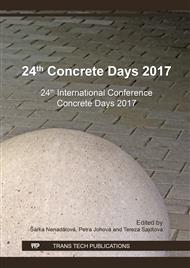[1]
ČSN P 73 2452: Fibre-reinforced concrete - Testing of hardened fibre-reinforced concrete. ÚNMZ, Prague, (2015).
Google Scholar
[2]
M. Tipka, Tensile Properties of Structural Fibre Reinforced Concrete, Ph.D. Thesis, CTU in Prague, Faculty of Civil Engineering, Prague, (2017).
Google Scholar
[3]
Model Code for Concrete Structures 2010. International Federation for Structural Concrete (fib), Lausanne, Switzerland, (2013).
Google Scholar
[4]
RILEM TC 162-TDF: Test and design methods for steel fibre reinforced concrete: Bending test. Final recommendation, in: Materials and Structures, Vol. 35, (2002).
DOI: 10.1617/13884
Google Scholar
[5]
RILEM TC 162-TDF: Test and design methods for steel fibre reinforced concrete: s-e-design methods. Final recommendation, in: Material and Structures, Vol. 36, (2003).
DOI: 10.1617/14007
Google Scholar
[6]
RILEM TC 162-TDF: Test and design methods for steel fibre reinforced concrete: Uni-axial tension test for steel fibre reinforced concrete, in: Material and Structures, Vol. 34, (2001).
DOI: 10.1617/13628
Google Scholar
[7]
M. Tipka, J. Vašková, Issues of Testing of Cementitious Composites in Uniaxial Tension, in: Proceedings from 22nd Czech Concrete Day 2015, Solid State Phenomena, Pfäffikon, Switzerland, (2016).
DOI: 10.4028/www.scientific.net/ssp.249.85
Google Scholar


